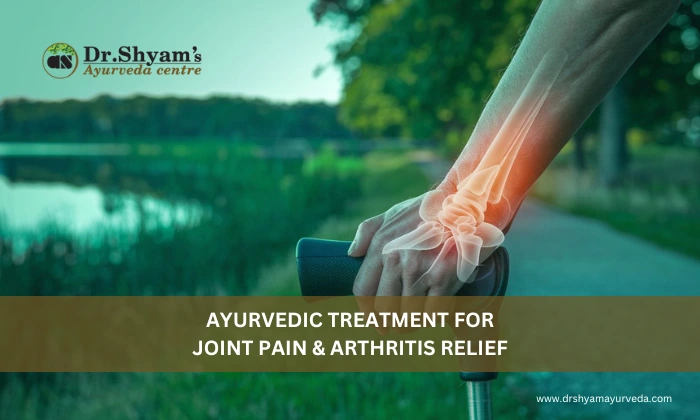Joint pain and arthritis can make everyday activities challenging, impacting mobility and overall well-being. Whether it’s stiffness in the morning, swelling in the knees, or chronic discomfort in the hands, these conditions affect millions of people worldwide.
Instead of relying solely on painkillers and temporary relief, Ayurveda offers a holistic and natural approach that targets the root cause of joint pain. With herbal remedies, Panchakarma therapies, diet and lifestyle modifications, Ayurveda aims to restore balance, reduce pain and swelling, and promote long-term joint health. Let’s explore arthritis in Ayurveda and the Ayurvedic treatments for joint pain in Dubai.
Understanding Ayurvedic Treatment for Joint Pain & Arthritis in Ayurveda
According to Ayurveda, joint pain primarily results from an imbalance in Vata dosha, which governs movement and body functioning. When Vata dosha is aggravated, it can lead to dryness, stiffness, and pain in the joints. Additionally, improper digestion leads to the accumulation of Ama (toxins), which settles in the joints and causes associated symptoms.
In addition to Vata dosha, the involvement of Pitta dosha and Kapha dosha can contribute to different types of arthritis.
Types of Arthritis in Ayurveda
Ayurveda classifies arthritis into different types based on dosha imbalances:
- Sandhigata Vata: Aggravated vata dosha accumulates in the joints and causes pain, swelling, crepitus and reduced flexibility.
- Amavata: Amavata refers to the simultaneous presence of vitiated Ama and Vata in the joints leading to body aches, a lack of appetite, thirst, fever, and
- Indigestion. As the condition progresses, it affects the hands, feet, ankles, and knees, causing pain, swelling, stiffness, and soreness in the affected joints.
- Vatarakta: Vatarakta is a chronic joint condition accompanied by pain, stiffness, and swelling in joints involving vitiated Vata dosha and Rakta dhatu.
- Asthigata Vata: Asthigata Vata is a condition in which Vata affects the bones, leading to osteoporosis and pain.
Top Ayurvedic Treatments for Joint Pain
Ayurvedic treatment for joint pain and arthritis aims to balance the vitiated doshas and eliminate accumulated toxins from the body. These therapies address the root cause of the disease rather than managing the symptoms.
It helps alleviate pain, nourishes the joints, improves mobility and prevents further degeneration. By integrating Panchakarma therapies, herbal remedies, diet and lifestyle modifications, Ayurveda provides a holistic solution for long-term joint health.
Panchakarma Therapies
Panchakarma(detoxification therapy) for joint pain aims at eliminating toxins from the body through the nearest possible route. It helps relieve pain, strengthens the immune system, reduces swelling and normalizes the vitiated doshas. The various panchakarma for joint pain include:
- Basti (Medicated enema): The finest therapy for Vata disorders, Basthi helps balance Vata, strengthen the joints, eliminate toxins, and promote overall wellness.
- Vamana (Medicated emesis): Vamana can be recommended to eliminate excess Kapha and toxins from the body in Kapha-associated arthritis.
- Virechana (Medicated purgation): Virechana can be recommended to eliminate excess Pitta and toxins from the body in Pitta-associated arthritis.
- Nasya: Nasya instills medicated oil through the nostrils and can be used to manage joint pain and arthritis in the upper body.
Abhyanga
Ayurvedic massage for arthritis involves using warm medicated oils to massage the body. It improves blood circulation, lubricates joints, and reduces pain and stiffness.
Herbal Remedies
Ayurvedic herbs are widely used in medicinal formulations and home remedies for managing arthritis and joint pain. Some of the common Ayurvedic herbs used for joint care include:
- Ashwagandha(Withania somnifera): Ashwagandha helps reduce stress, balances Vata dosha, improves muscle strength and nourishes the joints.
- Shallaki(Boswellia serrata): Its anti-inflammatory and antioxidant properties reduce swelling and pain associated with arthritis. Shallaki balances Vata dosha and helps prevent cartilage degeneration.
- Guggulu(Commiphora wightii): Its anti-inflammatory and anti-arthritic properties help reduce joint pain, swelling, and stiffness associated with various types of arthritis.
Dietary & Lifestyle Changes
Ayurveda emphasizes the importance of dietary and lifestyle recommendations in managing arthritis and joint pain. These help balance doshas, enhance digestion and promote overall joint health.
Dietary Recommendations
- Include a vata pacifying diet consisting of warm, moist, and nourishing foods such as soups, stews, whole grains, ghee, and cooked vegetables.
- Avoid processed, cold, and heavy foods such as deep-fried items, excessive dairy, and refined sugars.
- Incorporate anti-inflammatory foods such as turmeric, ginger, flaxseeds, and sesame seeds.
- Stay hydrated by drinking warm water and herbal teas like cumin or ginger.
Lifestyle Recommendations
- Engage in gentle exercises and yoga daily.
- Prioritize stress management through meditation, Pranayama, and relaxation techniques.
- Follow a consistent daily routine (Dinacharya) to regulate bodily rhythms.
- Ensure adequate rest and sleep.
Best Ayurvedic Oils for Arthritis
Ayurveda recommends a range of herbal formulations to alleviate joint pain, reduce inflammation, and promote long-term mobility.
Ayurvedic Oils
- Mahanarayana Oil helps relieve pain, strengthens bones and muscles, and improves joint flexibility.
- Dhanwantharam Oil is commonly used to manage vata disorders, including Rheumatoid arthritis, osteoarthritis, spondylosis, and neuromuscular conditions.
- Castor Oil helps relieve pain and inflammation around the joints and muscles and increases circulation in the body.
Herbal Decoctions
- Rasnaerandadi Kashayam helps relieve joint pain, stiffness, and inflammation, particularly in Vata-related arthritis.
- Sahacharadi Kashayam is effective in managing joint disorders, lower back pain and sciatica.
- Punarnavadi Kashayam is a natural diuretic and anti-inflammatory formulation that reduces joint swelling and fluid retention.
- Kottamchukkadi Choornam is used externally for pain relief and inflammation.
Yoga and Exercise for Joint Health
Ayurveda emphasizes the importance of gentle movements, such as yoga and stretching exercises, to prevent stiffness and enhance joint mobility and circulation.
Recommended Yoga Poses for Joint Health
Yoga asanas can reduce pain and swelling, improve flexibility, stability and range of motion, and prevent the long-term complications of arthritis. The common yogic postures include:
- Downward-Facing Dog (Adho Mukha Svanasana)
- Triangle Pose (Trikonasana)
- Camel Pose (Ustrasana)
- Seated Forward Bend (Paschimottanasana)
- Bow Pose (Dhanurasana)
- Bridge Pose (Setu Bandhasana)
Physical Exercise for Joint Health
Low-impact exercises like walking, swimming, and mild stretching can be highly beneficial in individuals with joint health issues. They prevent stiffness, enhance blood circulation, strengthen muscles and ligaments, and promote mental well-being.
Find Lasting Relief: Ayurvedic Treatments for Joint Pain & Arthritis at Dr. Shyam Ayurveda
Ayurveda offers a natural, effective, and long-term approach to managing joint pain and arthritis by addressing the root cause. At Dr. Shyam’s Ayurveda- the best Ayurvedic clinic in Dubai, we are committed to providing authentic Ayurvedic treatments that promote healing, restore mobility, and enhance overall well-being. Under the guidance of experienced Ayurvedic physicians, our personalized therapies, herbal remedies, and lifestyle recommendations ensure sustainable joint health.
Take the first step towards pain-free living with Ayurveda. Book your consultation today!
Frequently Asked Questions
1.Can Ayurveda cure atrhritis?
While Ayurveda may not “cure” arthritis completely, especially in the case of chronic types like osteoarthritis or rheumatoid arthritis, it can certainly help manage the symptoms and improve your quality of life. Ayurvedic treatments focus on balancing the body’s natural energies (called doshas), reducing inflammation, and strengthening the joints. With consistent use of herbs, therapies, and lifestyle adjustments, many people experience significant relief, with reduced pain, improved mobility, and overall better joint health. Think of Ayurveda as a holistic approach to managing arthritis rather than a quick fix.
2.How long does it take to see results from Ayurvedic treatment for joint pain?
The time it takes to feel relief from joint pain with Ayurvedic treatment can vary. Some people notice improvements within a few weeks, especially if they’re using herbs and therapies consistently. However, for more noticeable, long-term relief, it might take a few months. Factors like the severity of arthritis, your overall health, and how committed you are to the treatment plan all play a role in how quickly you’ll see results. Patience is key with Ayurvedic treatments, as they work gradually to restore balance and healing.











